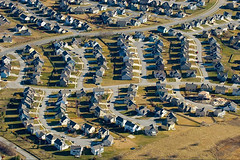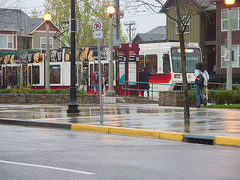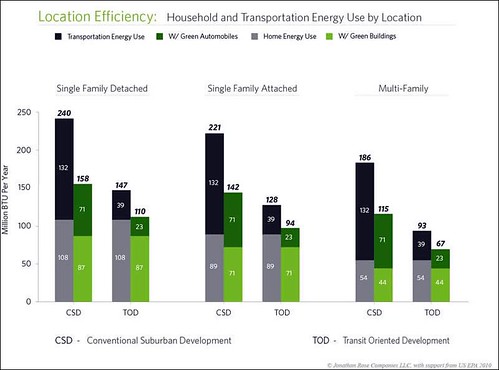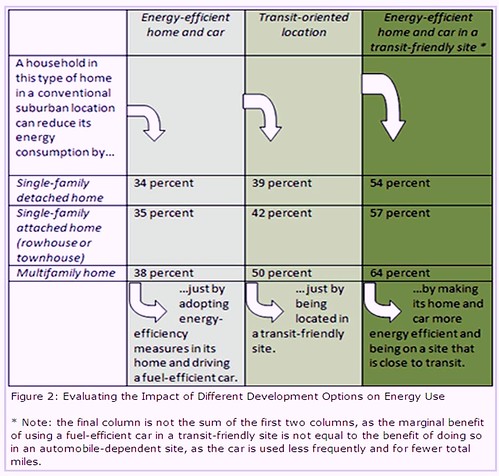Households in transit-oriented locations save more energy and emissions than even 'green' households in sprawl

Posted February 24, 2011 at 1:33PM
A new, peer-reviewed analysis performed by the staff of Jonathan Rose Companies, with assistance from the federal EPA, shows the power of a superior location in substantially reducing a household’s environmental footprint. In fact, it shows this is so whether the housing type is a single-family home, townhome, or multi-family building. In particular, a comparison based on national averages indicates that the energy consumption (and, thus, global warming emissions) of a typical household in a transit-oriented location is likely to be less than that of a household in a conventional suburban location (i.e., “sprawl”), even if the household in a conventional suburban location employs energy-efficient building technology and drives fuel-efficient vehicles.
Or, as my friend Steve Mouzon might put it, “gizmo green” features based on technology can’t beat the “original green” savings of good location decisions. The most energy efficiency and GHG reduction occurs, of course, if the household is given both a transit-oriented location and the benefit of green building and vehicle technology. The analysis was published yesterday on EPA’s website.
Consider the somewhat complicated series of bar graphs above. Combining the BTUs (British Thermal Units, a measure of energy use that correlates with GHG emissions) required for both transportation and building energy for each household type and location, the graph indicates the effects of different combinations. On the far left, for example, the most energy-intensive household type is the single-family detached house in a conventional suburban location; most of its energy use (132 million BTU per year) is for transportation; the rest (108 million BTU per year) is for building and appliances operation. Counting both forms of energy use, it requires an average of 240 million BTU per year.
If we green that same same household with energy-efficient building technology and fuel-efficient vehicles, we can reduce its footprint from 240 to 158 million BTU per year. That is not insignificant. But simply putting the same household in a better location, without any greening whatever, would reduce BTU requirements even further, to 147 million BTU per year. The location improvement outperforms the technology improvement, because of reduced energy requirements for transportation (i.e., fewer and shorter car trips). To do even better still, green the single-family household in the transit-oriented location, and we’re down to 110 million BTU per year, only 46 percent of the energy required for the conventional single family detached home in the conventional suburban location.
The same sort of comparison yields similar results for single-family attached homes (townhouses) and for multi-family homes (condos or apartments). On the far right of the chart, a multi-family home in a transit-oriented location with green building features and energy-efficient vehicles generates the lowest energy usage of all, 67 million BTU per year, only 28 percent of that required by the conventionally located and designed single-family home.
To explain, EPA has created a flow chart that indicates the various increments of energy efficiency improvement one can achieve by moving along the spectrum from totally conventional households to the most highly efficient households when both transportation and building energy are considered.
This analysis and bar chart represent an update to a chart that I have long used in my presentations. Over the years, it has probably been my most requested slide. The analysis isn’t perfect, of course, since real world situations vary and may not be captured fully in a comparison based on averages. There are also assumptions, based on research and judgment, that go into the analysis. The peer reviewers (disclosure: I was one) did not find any of them to be unreasonable.
The upshot? We cannot fix our energy use and global warming emissions problems by looking only at building and vehicle technology; we also have to look at land use and transit.
Move your cursor over the images for credit information.



